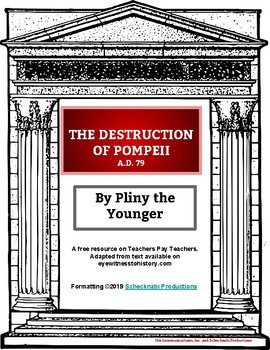The Destruction of Pompeii, by Pliny the Younger "Teaching with Primary Sources"
888 Downloads
Schecknabi Productions
7 Followers
Grade Levels
6th - 12th, Homeschool
Resource Type
Standards
CCSSRI.6.1
CCSSRI.6.2
CCSSRI.6.3
CCSSRI.6.4
CCSSRI.6.5
Formats Included
- PDF
Pages
15 pages
Schecknabi Productions
7 Followers
Description
Track back to the Schecknabi Productions Storefront in Early to Mid-February 2019 to purchase the following related resources!
For now, enjoy this free content!
Part of a Bundle!
THE DESTRUCTION OF POMPEII
- Summative Assessment: Journal Entry with Rubric
- Perspective-Taking writing assignment to foster empathy with historical figures
- Helps students understand the events of the eruption of Vesuvius
- Formative Assessments
- Graphic Organizers including:
- Analyzing a Primary Source for:
- Facts, Dates, Historical Figures, & Events
- Author, Date, Audience, Bias
- "Multiple Readings of a Text" Scaffolded Notes
- Reading Comprehension
- Defining Terms
- Sequencing Events
- Critical Thinking Guided Reading Page
- Identifying the Greek Worldview
- Definitions of Key Terms & Definitions
- Vocabulary Scramble Cards
- Anchor Charts
- Bulletin Board Terms
- Analyzing a Primary Source for:
Part of a Series!
TEACHING WITH PRIMARY SOURCES
The Destruction of Mt. Vesuvius, A.D. 79 by Pliny the Younger
Julius Caesar Crosses the Rubicon
and...more to come!
Total Pages
15 pages
Answer Key
N/A
Teaching Duration
Other
Report this resource to TPT
Reported resources will be reviewed by our team. Report this resource to let us know if this resource violates TPT’s content guidelines.
Standards
to see state-specific standards (only available in the US).
CCSSRI.6.1
Cite textual evidence to support analysis of what the text says explicitly as well as inferences drawn from the text.
CCSSRI.6.2
Determine a central idea of a text and how it is conveyed through particular details; provide a summary of the text distinct from personal opinions or judgments.
CCSSRI.6.3
Analyze in detail how a key individual, event, or idea is introduced, illustrated, and elaborated in a text (e.g., through examples or anecdotes).
CCSSRI.6.4
Determine the meaning of words and phrases as they are used in a text, including figurative, connotative, and technical meanings.
CCSSRI.6.5
Analyze how a particular sentence, paragraph, chapter, or section fits into the overall structure of a text and contributes to the development of the ideas.





